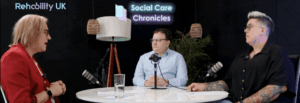There is a well-known African proverb that frequently comes up in conversations about health and social care. ‘If you want to go fast, go alone, if you want to go far, go together’. Its applicability rings true in a myriad of contexts, echoing a common lesson. Coproduction is key to quality. At Nourish we apply this maxim to every aspect of our development cycle. Drawing upon our users, like IBC Healthcare, and their communities to design software that is efficient, effective and always puts the person being supported first. On our tenth anniversary this focus is expanding beyond our initial application. A direct result of our perception of social care technology being expanded through our relationships with Nourish users. These relationships inform our new products, and shape their development through our Early Adopters Programme.
We sat down with Anna Goscombe, Director of Quality & Therapeutic Services at IBC Healthcare, to discuss our exciting new Incident and Accident management software, Nourish Safety. As well as the vital role her service plays in its development.



Why did you join the Early Adopters Programme for Nourish Safety?
“We knew it would be good for both parties. We’ve worked quite closely with you over the past few months as part of the Early Adopters Programme. We felt the time was right to engage with Nourish Safety because we were in a position where our current platform for that type of software solution was not fit for purpose for us. There were no plans for that particular supplier to develop their platform into what we needed. So we reached out to Nourish, as we were already using Better Care, to have an open conversation about what we needed for incident and accident management.
“What was really impressive is that you responded by showing us your roadmap. We committed to working with you because we feel confident with Nourish. You always deliver on what you say you will do.



What functionality did you want to develop with Nourish for incident and accident management?
“At IBC Healthcare we’re about homes, not hospitals. That goes for both our supported living and residential services. We love empowering people to be as independent as they possibly can be. While managing risks effectively. Which requires highly customisable and personalisable functionality to match our approach. We wanted a software that could support that commitment.
“We support some extremely complex people, with an average of three to one ratio staffing at times. For us, understanding the complexity of a person’s needs is not just about the initial transition into their new home with us. But rather asking, ‘how do we create sustainability and longevity for the people utilising our service?’
“In action, because of the high acuity and high complexity of the people we support, we need to make sure that we’re recording a high level of detail. We need to capture every aspect of someone’s experience. Particularly in behaviour incidents which are common for us. In addition, these details need to be on a system that provides a user-friendly platform for our staff teams. And has a functionality within that that allows us to review and manage said incidents. Because often some of those aspects are separate.”



Quite a comprehensive list, how have you found the process of working with Nourish?
“We feel like we work in partnership with you, as a provider to a provider. That collaborative working is so good, I think the process really works. I don’t think everyone does that, you know? And it’s not just ‘doing it to say you did it’. Nourish facilitated our collaboration really well. So, it’s enabled us, we engage in it in the best way that we possibly can. It’s been really successful and continues to be as the rollout comes. We really feel like we’re in a partnership.”
What makes working with Nourish feel like a partnership?
“First of all, naturally, Nourish would ask us as a provider about our challenges, what gaps we have, what we are looking to fill. We felt that there was a genuine interest in our service and community. An understanding of what those gaps were and a desire to help us address them.
“Additionally, some colleagues and I were invited up to your offices to spend time with your team. Which was a nice opportunity to meet people in person and get to know one another. It’s clear everyone involved wanted to understand how we could build the best solution together. Firstly, for the people we support, but also the best system for staff to use. It never felt like a tick box exercise. It’s way beyond that where everyone involved wants to genuinely create something good that’s going to work for everyone it impacts.



“In my experience that’s such a unique approach. Working alongside a supplier to address the root of the challenges we face and understand them. There were so many questions and dialogue during that day and it was so useful.
“We’ve attended a couple of separate follow up get togethers as part of that programme since. Getting to see the work that’s been done, and how our input is actioned. It shows that we weren’t just there for a discussion. You can clearly see our influence throughout the development. That is a true partnership in action.
“We felt listened to. We’re the people that are delivering it on the ground floor. We’re saying this is what is needed. To be involved like this is also reassuring, we’re not just waiting for nothing. We are 100% reassured that, ‘yeah, let’s stick with Nourish because they’re definitely going to deliver.”



Were there any unexpected benefits from this partnership?
“One of the main benefits is we’ve essentially already been planning the rollout in our organisation. Which means we’ve had time to discuss how it’s going to look and what we need to do to make sure it is effective.
“Normally it can take 3-6 months to embed a new system effectively. Whereas with Nourish’s incident and accident management functionality, we’ve been involved in the development along the way. We’ve tested parts and fed back any little changes we wanted made. Although we didn’t have much feedback recently, the last test was pretty spot on!
How does Nourish Safety support your complex care and LD services?
“Something that quickly becomes clear working with Nourish is the fact that you know providers are trying to drive that person centred approach. From a product perspective it ties in with us using the care planning on Nourish. Which is already person centred, and it’s got positives for so many reasons. But when you’ve then got the detailed incident management on there as well and event management, it all just flows. The workflow is just so much better because you’re using the same platform. You can go on someone’s timeline and see everything you need. It means that we’ve got less chance of missing things, or you can order it in a different way. Which makes understanding incidents and accidents so much easier.



“We feel we’ve had a pivotal role in helping shape behavioural workflows on the platform. As a provider offering complex care we had a definite requirement for an event form that was going to capture enough detail. It was a 100% must for us. Which gets back to working in a partnership with Nourish. We invested so much in this process so we can get the most out of it. And I know if you asked my colleague, he would firmly say and believe that, ‘Nourish have now got one of the best, if not the best product, on the market.’
“We take pride in being a part of that. At the end of last year we were looking for systems we could implement to solve these problems for us. We just couldn’t find one fit for purpose. A product that allows the detail to be inputted in a user-friendly way and at the same time gives you the opportunity to get the output from it. Take the dashboard for example, that’s going to give us the live data that we need. Data that’s going to be accurate. We weren’t able to get that before. There just wasn’t anything else that really ticked all the boxes for us, now we’ve helped build one!”



What are the main benefits you receive from using Nourish Safety?
“Our primary goal coming into this process was to provide a user-friendly platform for our staff teams. To have a functionality within that which allows us at IBC Healthcare to review and manage incidents and accidents. Because often some of those aspects are separate.
“The best bit is the fact that we can then review and manage that information effectively. The product has the ability to attach an investigation to an incident at the debrief. Which is one of the most important things because at the moment we still use paper for that. So that then becomes paperless and automatically attached to an incident. That’s one of the biggest things for us.
“What Nourish has achieved is a genuinely user-friendly platform. It doesn’t ask for unnecessary text. You can use placeholders for managers so you can focus on what you need to in the moment. It’s everything you need in one place, and it’s easy to action, that’s what we need. It’s super user friendly and there are benefits felt at every level of the organisation.”



What is a benefit for your support workers?
“For our Support Workers it’s going to be a lot easier for them to understand what is expected of them when filling an incident in. Which reduces the amount of training that we need, especially when it’s repeated training. Previously, we regularly conducted repeat training to try and coach people through how to effectively write an incident. The new functionality is going to really improve that. Which directly impacts the quality of our responses to incidents and the support we provide going forward.”
“With good incident management you can also provide the right staff support. Debrief for us is something that we wanted to improve on. Because when you’re working with such complex high acuity people naturally it’s emotionally demanding for staff. Managing incidents effectively is important to avoid staff burnout. Which then positively impacts the care and support they deliver. Nourish allows us to ensure that debriefs are completed in a timely fashion. They’re attached to the incident and that we can go and find them easily. Rather than searching through folders and asking everyone if they’ve seen a form, it just gets done. I think that feature in particular, having a debrief attached to the incident, is going to make a huge difference.
What is a benefit for your managers?
“I mentioned it briefly previously, the ability to use placeholders. When you record an incident in the moment your team member might not have time to put all the detail in. With Nourish you can use a what is effectively a placeholder and continue filling in the important details later. Crucially, you still have the notification so you can see that something has happened and respond to it. That feature is quite nifty for our managers especially.”



What is a benefit for the people using your service?
“In short? This system means they could potentially get any attention or response that they need. And get it quickly. Especially if it’s an emergency response or we need to send somebody out within the organisation. If someone’s not got time to write all the detail, they could still flag the incident. We’ll give them a call to make sure everything’s OK, which in turn benefits the person we support.
“We’ve got processes in place internally whereby we review and analyse incidents. I think to be able to do that quicker is beneficial and with Nourish we will be able to do it quicker. In part thanks to that placeholder functionality as well.
“Sometimes in the past we weren’t being notified of incidents until two or three days down the line because they weren’t being completed. Obviously, that’s not going to happen anymore.”
How does Nourish help you prepare for the future?
“It’s a game changer. The reporting functionality on our current platform isn’t brilliant. Additionally, for a whole host of reasons, the incident detail wasn’t good enough. Or sometimes it was delayed because information was siloed on different platforms. This all meant you couldn’t rely completely on the accuracy of the data. Or you couldn’t respond quick enough. So again, for all those reasons Nourish improves the quality of service that we’re providing to the person we support because we’ve got a better handle and a better management of incidents. We can better map the trends.
“What I mean when I say map trends, is that we can really understand the full picture. For example, ‘what might be the triggers here for this person?’ or ‘is it specifically happening in the home, is it specifically in the community where most incidents are occurring?’
“With the dashboard and Nourish you’re going to have that information quite quickly. For example, you can see how many restrictive physical interventions there have been. You can check important factors like if any restraints were used. We can then review previous data and see there were three restraints this month. But there was none for the last two months. Clearly something’s happened.
“It is crucial we can notice those things and be able to record triggers like that when providing LD and mental health services. It’s important to do it, but also important to do it in a in a timely manner. Local authorities, placing authorities, commissioners, they all expect it. They expect us to analyse that sort of data, but also to foresee any potential risk or escalation in incidents. More than that, we expect it of ourselves.
“Understanding incidents, whether they are basic or complicated, can potentially prevent a hospital readmission, or discharge to another service or staff burnout.
“Ultimately, it’s about providing personalised, centralised support for people so they can live the lives they want. It starts with safety, and that’s why we’re so excited to be building this product with Nourish.”
Find out more about Nourish Safety
Find out more about Nourish Safety and how it can transform your approach to Incidents & Accidents.








